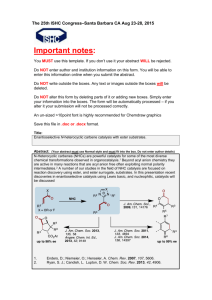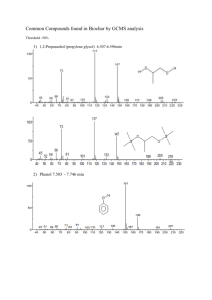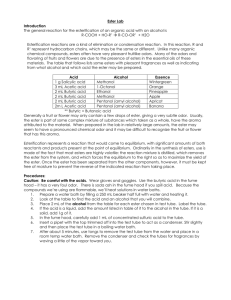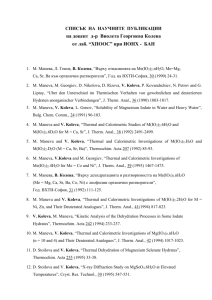Spectroscopic elucidation of hydrogensquarate and ester amide of
advertisement
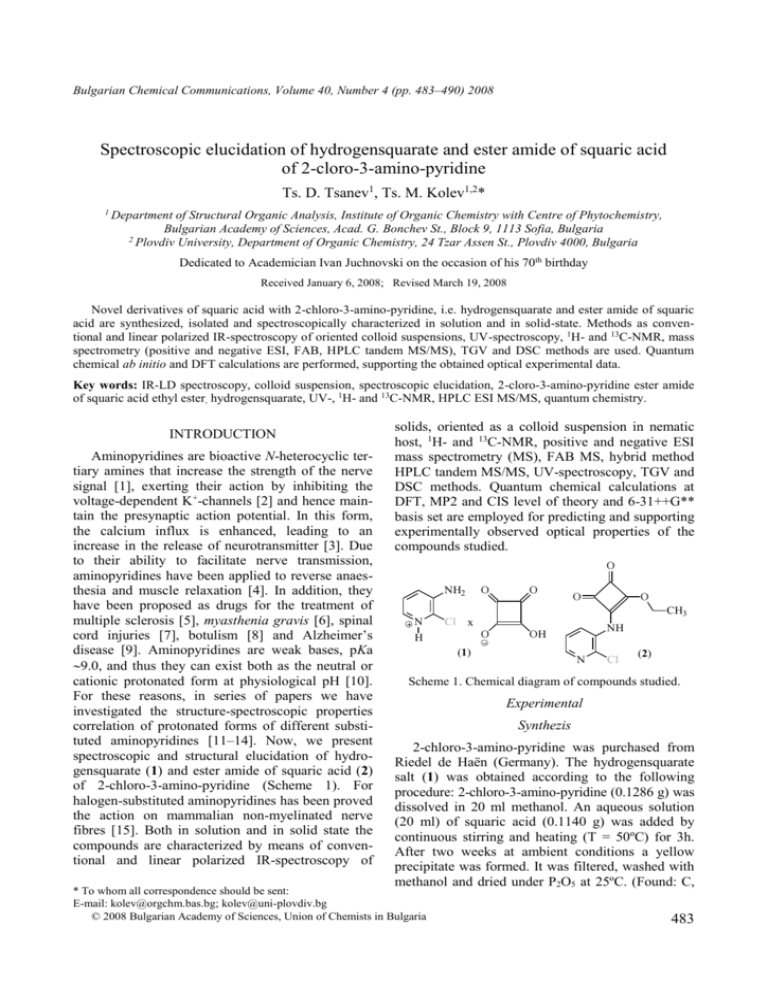
Bulgarian Chemical Communications, Volume 40, Number 4 (pp. 483–490) 2008 Spectroscopic elucidation of hydrogensquarate and ester amide of squaric acid of 2-cloro-3-amino-pyridine Ts. D. Tsanev1, Ts. M. Kolev1,2* 1 Department of Structural Organic Analysis, Institute of Organic Chemistry with Centre of Phytochemistry, Bulgarian Academy of Sciences, Acad. G. Bonchev St., Block 9, 1113 Sofia, Bulgaria 2 Plovdiv University, Department of Organic Chemistry, 24 Tzar Assen St., Plovdiv 4000, Bulgaria Dedicated to Academician Ivan Juchnovski on the occasion of his 70th birthday Received January 6, 2008; Revised March 19, 2008 Novel derivatives of squaric acid with 2-chloro-3-amino-pyridine, i.e. hydrogensquarate and ester amide of squaric acid are synthesized, isolated and spectroscopically characterized in solution and in solid-state. Methods as conventional and linear polarized IR-spectroscopy of oriented colloid suspensions, UV-spectroscopy, 1H- and 13C-NMR, mass spectrometry (positive and negative ESI, FAB, HPLC tandem MS/MS), TGV and DSC methods are used. Quantum chemical ab initio and DFT calculations are performed, supporting the obtained optical experimental data. Key words: IR-LD spectroscopy, colloid suspension, spectroscopic elucidation, 2-cloro-3-amino-pyridine ester amide of squaric acid ethyl ester, hydrogensquarate, UV-, 1H- and 13C-NMR, HPLC ESI MS/MS, quantum chemistry. INTRODUCTION Aminopyridines are bioactive N-heterocyclic tertiary amines that increase the strength of the nerve signal [1], exerting their action by inhibiting the voltage-dependent K+-channels [2] and hence maintain the presynaptic action potential. In this form, the calcium influx is enhanced, leading to an increase in the release of neurotransmitter [3]. Due to their ability to facilitate nerve transmission, aminopyridines have been applied to reverse anaesthesia and muscle relaxation [4]. In addition, they have been proposed as drugs for the treatment of multiple sclerosis [5], myasthenia gravis [6], spinal cord injuries [7], botulism [8] and Alzheimer’s disease [9]. Aminopyridines are weak bases, pKa 9.0, and thus they can exist both as the neutral or cationic protonated form at physiological pH [10]. For these reasons, in series of papers we have investigated the structure-spectroscopic properties correlation of protonated forms of different substituted aminopyridines [11–14]. Now, we present spectroscopic and structural elucidation of hydrogensquarate (1) and ester amide of squaric acid (2) of 2-chloro-3-amino-pyridine (Scheme 1). For halogen-substituted aminopyridines has been proved the action on mammalian non-myelinated nerve fibres [15]. Both in solution and in solid state the compounds are characterized by means of conventional and linear polarized IR-spectroscopy of solids, oriented as a colloid suspension in nematic host, 1H- and 13C-NMR, positive and negative ESI mass spectrometry (MS), FAB MS, hybrid method HPLC tandem MS/MS, UV-spectroscopy, TGV and DSC methods. Quantum chemical calculations at DFT, MP2 and CIS level of theory and 6-31++G** basis set are employed for predicting and supporting experimentally observed optical properties of the compounds studied. O O NH2 O O O CH3 N Cl x O H NH OH (1) N Cl (2) Scheme 1. Chemical diagram of compounds studied. Experimental Synthezis 2-chloro-3-amino-pyridine was purchased from Riedel de Haën (Germany). The hydrogensquarate salt (1) was obtained according to the following procedure: 2-chloro-3-amino-pyridine (0.1286 g) was dissolved in 20 ml methanol. An aqueous solution (20 ml) of squaric acid (0.1140 g) was added by continuous stirring and heating (T = 50ºC) for 3h. After two weeks at ambient conditions a yellow precipitate was formed. It was filtered, washed with methanol and dried under P2O5 at 25ºC. (Found: C, * To whom all correspondence should be sent: E-mail: kolev@orgchm.bas.bg; kolev@uni-plovdiv.bg © 2008 Bulgarian Academy of Sciences, Union of Chemists in Bulgaria 483 Ts. D. Tsanev and Ts. M. Kolev: Spectroscopic elucidation of hydrogensquarate and ester amide of squaric acid… 44.59; H, 2.90; N, 11.50; [C9H7N2O4Cl] calcd.: C, 44.56; H, 2.91; N, 11.55 %). Ester amide of squaric acid of 2-chloro-3-aminopyridine (2) was synthesized as follows: equimolar amounts of 2-chloro-3-amino-pyridine (0.1286 g) and ethyl ester of squaric acid (1 mmol) in 20 ml ethanol (95%) were mixed by continuous stirring at room temperature for 30 h. The formed yellow precipitate was filtered, washed with ethanol and dried under P2O5 at 25ºC. (Found: C, 52.50; H, 3.60; N, 11.10; [C11H9N2O3Cl] calcd.: C, 52.29; H, 3.59; N, 11.09%). The TGV and DSC data for (1) and (2) in the temperature range of 300–500K show an absence of the included solvent molecules in the both compounds. Materials and methods Conventional and polarized IR-spectra were measured on a Thermo Nicolet OMNIC FTIR-spectrometer (4000–400 cm–1, 2 cm–1 resolution, 200 scans) equipped with a Specac wire-grid polarizer. Non-polarized solid-state IR spectra were recorded using the KBr disk technique. The oriented samples were obtained as a colloid suspension in a nematic liquid crystal ZLI 1695. Its self-absorption bands are shown in Fig. 1. The theoretical approach, experimental technique for preparing the samples, procedures for polarized IR-spectra interpretation and the validation of this new linear-dichroic infrared (IRLD) orientation solid-state method for accuracy and precision has been presented in [16–19]. The influence of the liquid crystal medium on peak positions and integral absorbances of the guest molecule bands, the rheological model, the nature and balance of the forces in the nematic liquid crystal suspension system, mathematical model, and morphology of the suspended particles also been discussed [16–19]. The positive and negative ESI mass spectra were recorded on a Fisons VG Autospect instrument employing 3-nitrobenzylalcohol (Sigma-Aldrich) as the matrix. Ultraviolet (UV) spectra were recorded on a Tecan Safire Absorbance/Fluorescence XFluor 4 V 4.40 spectrophotometer operating between 190 and 900 nm, using solvents such as water, methanol, dichloromethane, tetrahydrofurane, acetonitrile, acetone, 2-propanol and ethyl acetale (all Uvasol, Merck products) in concentration of 2.5×10–5 M, using 0.0921 cm quarz cells. HPLC-MS/MS analysis. The analyses of the samples were performed with a Thermo Finnigan surveyor LC-Pump. Compounds were separated on a Luna C18 column (150×2 mm, 4 m particle size) from Phenomenex (Torrance, CA, USA). The mobile 484 phase consisted of water + 0.1% HCOOH (A) and acetonitrile + 0.1% HCOOH (B) using a gradient program. The compound was detected via UV and a TSQ 7000 (Thermo Electron Corporation, Dreieich, Germany) mass spectrometer. The spectra were obtained using the TSQ 7000 equipped with an ESI ion source and operated at the following conditions: capillary temperature 180ºC; sheath gas 60 psi and spray voltage 4.5 kV. 1 mg/ml of the sample was dissolved in acetonitrile and injected into the ion source by an auto sampler (Finnigan Surveyor). The obtained data were processed using the Excalibur 1.4 software. The molecular mass was determined using FAB mass spectra, measured on a Fusion VG Autospect instrument employing 3-nitrobenzyl alcohol as a matrix. Quantum chemical calculations were performed with GAUSSIAN 98 and Dalton 2.0 program packages [20, 21]. The output files were visualized by means of the ChemCraft program [22]. The geometries of Npy protonated form of 2-cloro-3amino-pyridine and the corresponding ester amide of squaric acid with 2-cloro-3-amino-pyridine were optimized at two levels of theory: second-order Moller-Pleset perturbation theory (MP2) and density functional theory (DFT) using the 6-31++G** basis set. The DFT method employed is B3LYP, which combines Backe’s three-parameter non-local exchange function with the correlation function of Lee, Yang and Parr. Molecular geometries of the studied species were fully optimized by the force gradient method using Bernys’ algorithm. For every structure, the stationary points found on the molecule potential energy hypersurfaces were characterized using standard analytical harmonic vibrational analysis. The absence of the imaginary frequencies, as well as of negative eigenvalues of the second-derivative matrix, confirmed that the stationary points correspond to minima of the potential energy hypersurfaces. The calculations of vibrational frequencies and infrared intensities were checked to establish which kind of performed calculations agree best with the experimental data. In our cases the DFT method provides more accurate vibrational data, as far as the calculated standard deviations of respectively 12 cm–1 (B3LYP) and 17 cm–1 (MP2) corresponding to groups, which do not participate in intra- or intermolecular interactions, are concerned. So, the B3LYP/6-31++G** data are presented for above discussed modes, where a modification of the results using the empirical scaling factor 0.9614 is made to achieve better correspondence between the experimental and theoretical values. The UV spectra in the gas phase and in ethanol solution were obtained by CIS/6- Ts. D. Tsanev and Ts. M. Kolev: Spectroscopic elucidation of hydrogensquarate and ester amide of squaric acid… 31++G** and TD-DFT calculations. The thermal analyses were performed in the 300–500K region on a Differential Scanning Calorimeter Perkin-Elmer DSC-7, and a Differential Thermal Analyzer DTA/TG (Seiko Instrument, model TG/DTA 300). The experiments were carried out with scanning rate of 10 K/min under an argon atmosphere. The elemental analysis was carried out according to the standard procedures for C and H (as CO2, and H2O) and N (by the Duma’s method). RESULTS AND DISCUSSION The non polarized IR-spectra of (1) and (2) are depicted in Fig. 1. The 3500–300 cm–1 IR-spectroscopic region of the first compound is characterized by a series of maxima (Fig. 2), which can be assigned as follows: 3410 cm–1 (νasNH2), 3323 cm–1/ 3202 cm–1 (νsNH2) and the band within 3100–3000 cm–1 – to in-plane (i.p.) CH-stretching vibrations of pyridine ring. The observation of Fermi resonance spitted band of νsNH2 has been previously observed in pyridinium derivatives [23–25]. When a given NH2-group participates in asymmetric intermolecular interactions NH2…X, the νsNH2 is observed as two bands, which are eliminated at equal dichroic ratio with the δNH2 vibration [23–25]. In our system, the elimination of the band at 3323 cm–1 leads to the disappearance of the second one at 3202 cm–1 as well as the IR-maximum at 1698 cm–1. As far as the transition moments of νsNH2 and δNH2 are co-linear oriented in the frame of one NH2-fragment, the band at 1698 cm–1 can de assigned to scissoring NH2 bending vibration. The broad band within 3000– 2000 cm–1 corresponds to νOH stretching vibration of hydrogensquarate moieties. The type of the IR-spectroscopic pattern is typical for hydrogensquarates, when two anions form stable dimmers [26]. The intensive bands at 1808, 1646 and 1550 cm–1 belong to νsC=O(Sq), νasC=O(Sq) and νC=C(Sq) of hydrogensquarate anions. The calculated values are 1826, 1650 and 1560 cm–1, respectively. The strong intensity of these bands and their broad character make difficult the interpretation of the i.p. stretching vibration of pyridinium ring, observed within 1650–1450 cm–1 region by means of polarized IR-LD spectroscopy. Within the IR-spectroscopic region 900–450 cm–1 are observed a series of well-defined bands. The maxima at 854, 680 and 640 cm–1 are assigned to out-of-plane (o.p.) modes of pyridine ring and are eliminated at equal dichroic ratio. The theoretical values are 852, 681 and 638 cm–1, respectively. The band at 713 cm–1 (theoretical value of 700 cm–1) corresponds to νC–Cl and the observed simultaneous elimination (Fig. 3.2.) with the bands at 794 and 573 cm–1, indicates that last bands corresponds to i.p. modes of pyridine ring. (2) (1) 3500 3000 2500 2000 1500 1000 500 Absorbance / Wavenumber (cm-1) Fig. 1. IR-spectra of (1) and (2) in solid-state. Filled regions indicate the self-absorption of the mesophase. 485 Ts. D. Tsanev and Ts. M. Kolev: Spectroscopic elucidation of hydrogensquarate and ester amide of squaric acid… 3033 1607 3323 3202 3401 vibration. The i.p. pyridine modes are observed at 1640, 1607 and 1500 cm–1 and are eliminated at equal dichroic ratio (Fig. 4.2). The values are typical for pyridinium derivatives [27]. 1640 3091 (2) 3400 3350 3300 3250 3200 3150 3100 3050 3000 Absorbance / Wavenumber (cm-1) Fig. 2. Curve-fitted IR-spectrum of (1) within 3450–3000 cm–1 IR-region (χ2 value is 4×10–5). (1) 1800 1750 1700 1650 1600 1550 1500 Absorbance / Wavenumber (cm-1) (2) Fig. 4. Non-polarized IR- (1) and reduced IR-LD (2) spectrum of (2) after elimination of the band at 1607 cm–1. 573 793 713 The experimentally observed IR-spectroscopic data are supported by theoretical quantum chemical spectra (Fig. 5). Comparison between the theoretical and experimental values shows a difference less then 2 cm–1 for i.p. vibrations of pyridine ring, 7 cm–1 for o.p. modes and within 10–17 cm–1 for νNH and νεC=O stretching vibrations of squaric acid residues. These data can be explained with the participations of these groups in intermolecular interactions, typical in solid state and are similar for other ester amides of squaric acid [28, 29]. UV-spectra (1) 900 850 800 750 700 650 600 550 Absorbance / Wavenumber (cm-1) Fig. 3. Non-polarized IR- (1) and reduced IR-LD (2) spectrum of (1) after elimination of the band at 713 cm–1. The IR-spectrum of (2) in solid-state is characterized with an intensive band at 3225 cm–1 belonging to νNH stretching vibration. The symmetric and asymmetric stretching modes of squarate fragment are low- and high-frequency shifted and are observed at 1798 and 1704 cm–1. The intensive band at 1564 cm–1 C=C stretching 486 The UV-spectra of 2-cloro-3-amino-pyridine, its hydrogensquarate and ester-amide of squaric acid are depicted in Fig. 6. The compounds are characterized with a band at 277 nm (ε = 10000–9865 l·mol–1·cm–1). Both in the Npy protonatated form (1) and in ester amide (2) the complex band does not affect significantly. The charge transfer band over than 350 nm (ε = 10178–12561 l·mol–1·cm–1) is batochromic shifted as a result of protonation or formation of the ester-amide derivative (Fig. 6). In contrast to protonated forms of 4-aminopyridine [30] and 3,4-diaminopyridine [12], the Npy protonation in 2-cloro-3-amino-pyridine does not affect the aromatic character of pyridine ring. These Ts. D. Tsanev and Ts. M. Kolev: Spectroscopic elucidation of hydrogensquarate and ester amide of squaric acid… results are predicted theoretically as well where our TD-DFT calculations in ethanol solution give better results, after a comparison with corresponding CIS data. The corresponding values are 377 nm (E = 4.21 eV, f = 0.0032) of 2-cloro-3-amino-pyridine, 390 nm (E = 5.11 eV, f = 0.1056) of Npy protonated form and 401 nm (E = 6.67 eV, f = 0.2546) in (2), respectively. 60 50 Absorbance 40 30 20 10 0 3500 3000 2500 2000 1500 1000 500 -1 Wavenumbers (cm ) Fig. 5. Non-scaled theoretical IR-spectra of protonated 2-cloro-3-amino-pyridine (solid line) and 2-cloro-3-amino-pyridine ester amide of squaric acid (dot line). 4 HPLC ESI MS/MS data A 3 2 (1) (2) 1 0 250 300 350 400 450 500 nm Fig. 6. UV-spectra of 2-cloro-3-amino-pyridine (dot line) its hydrogensquarate (1) and ester amide of squaric acid (2). The positive ESI mass spectrum of (1) shows a peak at m/z 129.44 corresponding to singly charged [C5H5N2Cl]+ with molecular weight of 129.57. The negative spectrum is characterized with peak at m/z 113.2, belonging to anion [C4HO4] with a molecular weight of 113.05. The ESI mass spectrum of (2), shown in Fig. 7, is characterized with a peak at m/z of 257.1, corresponding to singly charged cation [C11H10N2O3Cl]+ with a molecular weight of 253.66. The next fragmentation of chlorine leads to an observation of the signal at m/z 217.1. The peak at m/z 163.1 corresponds to [C8H7N2O2]+ with a molecular weight of 163.16. 487 Ts. D. Tsanev and Ts. M. Kolev: Spectroscopic elucidation of hydrogensquarate and ester amide of squaric acid… Fig. 7. ESI MS spectrum of (2). 2.2 1.5 1.0 1.0 1.0 ppm 9.0 8.5 8.0 7.5 7.0 6.5 6.0 5.5 5.0 4.5 Fig. 8. 1H-NMR spectra of (2). 488 4.0 3.5 3.0 2.5 2.0 Ts. D. Tsanev and Ts. M. Kolev: Spectroscopic elucidation of hydrogensquarate and ester amide of squaric acid… 1 H and 13C-NMR data in solution 1 H- and 13C-NMR spectra chemical shift signals are low affected as a result of protonation in the case of (1) or formation of the ester amide derivative – in (2) (Fig. 8). The chemical shift signals are observed at 8.01 ppm (H4), 8.40 ppm (H5) and 8.88 ppm (H6), respectively. This result also supports the UVspectroscopic ones, i.e. the protonation affected the aromatic character of pyridine in insignificant level. In (2) are observed additionally chemical signals for CH2 (3.7 ppm) and CH3 (2.1 ppm). 13C-NMR spectroscopic data of (1) and (2) show that the chemical signals of C2 are observed about 60.0 ppm. Other signals C3–C6 are within the range of 42.9–55.6 ppm, respectively. Four signals in the 13C-NMR spectra about 170.0, 177.5, 178.0 and 179.0 ppm, belong to squaric acid residues in (1) and (2), respectively. CONCLUSION Hydrogensquarate and ester amide of squaric acid of 2-chloro-3-amino-pyridine are synthesized, isolated and spectroscopically characterized in solution and in solid-state by means of conventional and linear polarized IR-spectroscopy of oriented colloid suspensions, UV-spectroscopy, 1H- and 13C-NMR, positive and negative ESI, FAB, HPLC tandem mass spectrometry (MS/MS), TGV and DSC methods. Quantum chemical ab initio and DFT calculations are performed, supporting the obtained optical experimental data. The correlation between the structure optical and magnetic properties of the newly synthesized compounds is performed. The effect of Npy protonation and the formation of the ester amide with squaric acid on the optical and magnetic properties of the 2-chloro-3-amino-pyridine specie/fragment in both the compounds are elucidated by a comparison of the properties of starting compound. Acknowledgements: The authors thank the Assoc. Prof. B. Koleva (St. Kliment Ohridski Sofia University) for the using of Dalton 2.0 program and helpful discussion. This work has been supported financially by Bulgarian National Fund of Scientific Research, Contract X– 1510. REFERENCES 1. J. Molgo, M. Lemeignan, F. Peradejordi, P. Lechat, J. Pharmacol. Paris., 16, 109 (1985). 2. G. E. Kirsch, T. Narahashi, Biophys. J., 22, 507 (1978). 3. J. Molgo, M. Lemeignan, P. Lechat, F. Peradejordi, Eur. J. Med. Chem., 20, 149 (1985). 4. C. Carlsson, I. Rosen, E. Nilsson, Acta Anaesthesiol. Scand., 27, 87 (1993). 5. S. R. Schwid, M. D. Petrie, M. P. McDermott, D. S. Tierney, D. H. Maso, A. D. Goodman, Neurology, 48, 817 (1997). 6. K. M. McEvoy, A. J. WindebankN, J. R. Daube, P. A. Low, N. Engl. J. Med., 321, 1567 (1989). 7. J. L. Segal, S. R. Brunnemann, Pharmacotherapy, 17, 415 (1997). 8. L. C. Sellin, Med. Biol., 59, 11 (1981). 9. M. Davidson, J. H. Zemishlany, R. C. Mohs, Biol. Psychiatry, 23, 485 (1988). 10. H. Meves, Y. Pichon, J. Physiol. Lond., 251, 60P (1979). 11. B. B. Koleva, T. Tsanev, T. Kolev, H. Mayer-Figge, W. S. Sheldrick, Acta Cryst., E63, o3356 (2007) 12. B. B. Koleva, T. Kolev, T. Tsanev, St. Kotov, H. Mayer-Figge, R. W. Seidel, W. S. Sheldrick, J. Mol. Struct., (2007), (in press). DOI: http://dx.doi.org/ 10.1016/j.molstruc.2007.09.006. 13. B. B. Koleva, T. Kolev, T. Tsanev, St. Kotov, H. Mayer-Figge, R. W. Seidel, W. S. Sheldrick, Struct. Chem., (2007) (in press). 14. B. B. Koleva, T. Kolev, R. W. Seidel, T. Tsanev, H. Mayer-Figge, M. Spiteller, W. S. Sheldrick, Spectrochim. Acta, Part A, (2007) (in press). 15. A Den Hertog, P Biessels, J Van den Akker, S Agoston, A. S Horn, Eur. J. Pharmacol., 142, 115 (1987). 16. B. B. Ivanova, M. G. Arnaudov, P. R. Bontchev, Spectrochim. Acta, 60, 855 (2004). 17. B. B. Ivanova, D. L. Tsalev, M. G. Arnaudov, Talanta, 69, 822 (2006). 18. B. B. Ivanova, V. D. Simeonov, M. G. Arnaudov, D. L. Tsalev, Spectrochim. Acta, 67A, 66 (2007). 19. B. B. Koleva, T. Kolev, V. Simeonov, T. Spassov, M. Spiteller, J. Inclus. Phenom., (2008) in press. 20. M. J. Frisch, G. W. Trucks, H. B. Schlegel, G. E. Scuseria, M. A. Robb, J. R. Cheeseman, V. G. Zakrzewski, J. A. Montgomery Jr., R. E. Stratmann, J. C. Burant, S. Dapprich, J. M. Millam, A. D. Daniels, K. N. Kudin, M. C. Strain, Ö. Farkas, J. Tomasi, V. Barone, M. Cossi, R. Cammi, B. Mennucci, C. Pomelli, C. Adamo, S. Clifford, J. Ochterski, G. A. Petersson, P. Y. Ayala, Q. Cui, K. Morokuma, P. Salvador, J. J. Dannenberg, D. K. Malick, A. D. Rabuck, K. Raghavachari, J. B. Foresman, J. Cioslowski, J. V. Ortiz, A. G. Baboul, B. B. Stefanov, G. Liu, A. Liashenko, P. Piskorz, I. Komáromi, R. Gomperts, R. L. Martin, D. J. Fox, T. Keith, M. A. Al-Laham, C. Y. Peng, A. Nanayakkara, M. Challacombe, P. M. W. Gill, B. Johnson, W. Chen, M. W. Wong, J. L. Andres, C. Gonzalez, M. Head-Gordon, E. S. Replogle, J. A. Pople, Gaussian 98, Gaussian, Inc., Pittsburgh, PA, 1998. 21. DALTON, a molecular electronic structure program, Release 2.0 (2005), http://www.kjemi.uio.no/software/ dalton/dalton.html. 22. G. A. Zhurko, D. A. Zhurko, ChemCraft: Tool for 489 Ts. D. Tsanev and Ts. M. Kolev: Spectroscopic elucidation of hydrogensquarate and ester amide of squaric acid… 23. 24. 25. 26. treatment of chemical data, Lite version build 08 (freeware), 2005. B. B. Ivanova, H. Mayer-Figge, J. Coord. Chem., 58, 653 (2005). M. G. Arnaudov, B. B. Ivanova, Sh. G. Dinkov, Vibr. Spectrosc., 37, 145 (2005). B. B. Koleva, E. N. Trendafilova, M. G. Arnaudov, W. S. Sheldrick, H. Mayer-Figge, Trans. Met. Chem. 31, 866 (2006). T. Kolev, B. B. Koleva, M. Spiteller, Amino Acids (2006) (in press). DOI 10.1007/s00726-006-0391-1 27. A. Katritzki, Advances in: Heterocyclic Chemistry, Vols. I-VI, 1964, and Vol. 35, 1984, Academic Press, N.Y. 28. T. Kolev, B. B. Ivanova, E. Cherneva, M. Spiteller, W. S. Sheldrick, H. Mayer-Figge, Struct. Chem., 17, 491. (2006) 29. T. Kolev, B. B. Koleva, M. Emgenbroich, M. Spiteller, W. S. Sheldrick, H. Mayer-Figge, Struct. Chem., 17, 631 (2006). 30. B. B. Ivanova, M. G. Arnaudov, H. Mayer-Figge, Polyhedron, 24, 1624 (2005). СПЕКТРАЛНО ОХАРАКТЕРИЗИРАНЕ НА ХИДРОГЕНСКВАРАТ И ЕСТЕР АМИД НА КВАДРАТНАТА КИСЕЛИНА С 2-ХЛОР-3-АМИНОПИРИДИН Ц. Цанев1, Ц. M. Kолев1,2* Институт по органична химия с център по фитохимия, Българската академия на науките, ул. „Акад. Г. Бончев“, бл. 9, 1113 София, 2 Пловдивски университет, Катедра „Органична химия“, ул. „Цар Асен“ № 24, 4000 Пловдив 1 Посветена на акад. Иван Юхновски по повод на 70-та му годишнина Постъпила на 6 януари 2008 г.; Преработена на 19 март 2008 г. (Резюме) Две нови производни на квадратната киселина с 2-хлор-3-аминопиридин, а именно хидрогенскварат и естер амид бяха синтерирани, исолирани и спектрално охарактеризирани в разтвор и твърдо състояние, използвайки методите на конвенционалната и линейно поларизирана ИЧ-спектроскопия на ориентирани проби като суспенция в нематичен течен кристал, УВ-спектроскопия, 1H- и 13C-ядрено магнитен резонанс, масспектрометрия (положителна и отрицателна ЙЕР, ЙББА, ВЕТХ тандемна MС/MС), а също така и термични методи. Квантово-химични ab initio и ТФП пресмятания са използвани с цел подпомагане и обяснение на получените експериментални данни. 490


